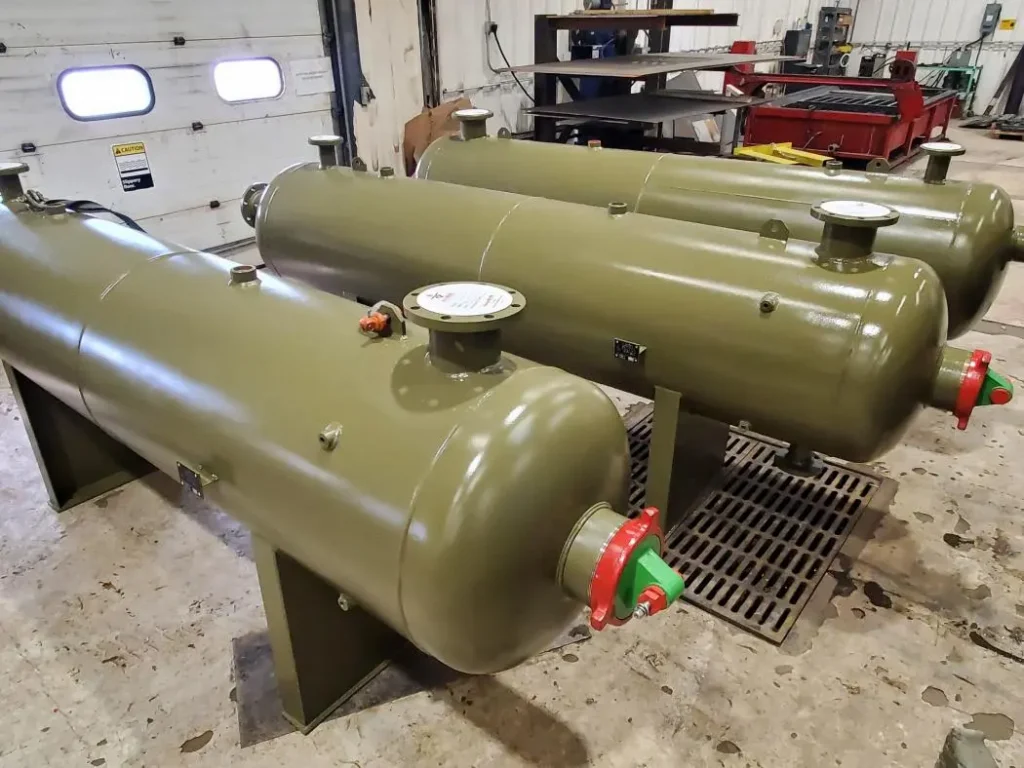
Introduction to a pressure vessel manufactured
A pressure vessel is a container specifically designed to hold gases or liquids at a pressure substantially different from the ambient pressure. These specialized containers play a pivotal role in a myriad of industries, from petrochemicals and pharmaceuticals to power generation and food processing. Their importance cannot be overstated, as they not only serve as storage and processing units but also ensure safety by containing potentially hazardous materials. Given the critical nature of their function, understanding how pressure vessels are manufactured is essential. This article delves into the intricate processes involved in the manufacturing of pressure vessels, shedding light on the materials, design considerations, and quality standards that ensure their reliability and efficiency.
Types of Pressure Vessels
Pressure vessels come in various shapes and sizes, each tailored to specific applications and industries. To better understand them, their classification can be based on both their shape and their intended purpose.
Classification Based on Shape:
Cylindrical Vessels:
These are the most common type, primarily characterized by their elongated cylindrical shape. Due to this design, they are often used in oil refineries and chemical plants because of their efficient volume-to-surface area ratio.
Spherical Vessels:
As the name suggests, these vessels are spherical. Typically, they are used for storing gases under high pressure, such as LPG (Liquefied Petroleum Gas). Because of their geometry, the surface area exposed to pressure is minimized, making them highly efficient.
Classification Based on Purpose:
Storage Vessels:
These vessels are mainly designed to store liquids or gases. Consequently, they are found in various industries, from storing crude oil in refineries to holding milk in dairies.
Heat Exchangers:
These vessels facilitate the transfer of heat between two or more fluids. Commonly, they are used in power plants and refrigeration systems. As a result, they play a crucial role in energy conservation and temperature regulation.
Reactors:
Used predominantly in the chemical and pharmaceutical industries, reactors are vessels where chemical reactions take place. They are designed to withstand not only pressure but also the corrosive or reactive nature of the substances they contain.
Materials Used in Pressure Vessel Manufacturing
The choice of material for a pressure vessel is paramount, as it directly influences the vessel’s strength, durability, and resistance to various environmental factors. Different applications and conditions necessitate the use of specific materials to ensure the vessel’s safety and longevity.
Metals: The Backbone of Many Vessels
Carbon Steel:
- Characteristics: Offers a balanced blend of strength and ductility, making it suitable for a wide range of applications.
- Applications: Widely used in oil refineries, water storage tanks, and steam boilers due to its cost-effectiveness and versatility.
- Variants: Different grades, such as low-carbon, medium-carbon, and high-carbon steel, offer varied properties suitable for specific applications.
Stainless Steel:
- Characteristics: Renowned for its corrosion resistance, stainless steel owes its properties to alloying elements like chromium and nickel.
- Applications: Preferred in chemical, pharmaceutical, and food processing industries where resistance to corrosive substances is crucial.
- Variants: Multiple grades, including austenitic, ferritic, and martensitic stainless steels, cater to different needs.
Aluminum:
- Characteristics: Lightweight, corrosion-resistant, and possesses good thermal conductivity.
- Applications: Aerospace, cryogenic storage, and certain chemical processing industries where weight and corrosion resistance are paramount.
- Variants: Different alloys of aluminum offer varied strengths and temperature resistances.
Non-metallic Materials:
Composites:
- Characteristics: Composites combine the strength of fibers (like carbon or glass) with the resilience of a matrix material, often a polymer.
- Applications: Used in modern pressure vessels for aerospace, automotive, and some high-tech industries due to their high strength-to-weight ratio.
- Advancements: Continuous research is leading to the development of newer composites with enhanced properties.
Polymers:
- Characteristics: While not as strong as metals, certain polymers excel in corrosion resistance and weight reduction.
- Applications: Suitable for vessels that store corrosive liquids or where weight is a significant concern.
- Variants: Different polymers, like polyethylene (PE) and polypropylene (PP), offer distinct properties.
Factors Determining Material Choice:
Corrosion Resistance:
To begin with, in environments or processes where corrosive substances are present, materials like stainless steel or specific polymers are preferred. This is because they help ensure the vessel’s longevity by resisting chemical degradation.
Temperature Limits:
Moreover, depending on the operational temperature, materials are chosen that can withstand both high and low extremes so that they maintain their structural integrity over time.
Pressure Limits:
In addition, the vessel’s intended pressure range will dictate the material’s required strength. Consequently, high-pressure applications often necessitate stronger materials or specific alloys.
Cost and Availability
From a practical standpoint, economic considerations and material availability can influence the choice. Especially in large-scale or mass-produced vessels, cost-efficiency becomes a key factor.
Innovations and Future Materials:
- As research progresses, newer materials with enhanced properties are being explored. Nano-engineered materials, advanced composites, and superalloys are some of the frontiers in pressure vessel material research.
- Sustainability and environmental considerations are also driving the search for eco-friendly materials and manufacturing processes.
Design and Engineering
The design and engineering phase is the backbone of pressure vessel manufacturing. It ensures that the vessel can safely contain its intended contents under specified conditions. A well-engineered design not only guarantees the safety of the vessel but also optimizes its performance and lifespan.
Importance of Design in Ensuring Safety:
To begin with, every pressure vessel operates under unique conditions, whether related to temperature, pressure, or the nature of its contents. Because of this, a meticulously crafted design is essential. It ensures that the vessel can withstand these conditions without failure, thereby safeguarding both the environment and human lives.
Factors Considered in Design:
Wall Thickness:
One of the primary considerations is the wall thickness, which determines the vessel’s ability to contain its contents under pressure. This factor is especially important because it is calculated based on the material’s strength, the vessel’s size, and the maximum operating pressure.
Stress Points:
Additionally, areas where components join or where there are changes in the vessel’s shape can become stress points. Therefore, the design must account for these to prevent premature failure.
Pressure Limits:
Likewise, every vessel has a maximum allowable working pressure (MAWP). To ensure safety, the design guarantees that the vessel can operate up to this limit without risking rupture.
Software Tools Commonly Used in Design:
- Modern pressure vessel design heavily relies on computer-aided design (CAD) tools. These software solutions allow engineers to create detailed 3D models, run simulations, and test the vessel’s performance under various conditions.
- Popular software like AutoCAD, SolidWorks, and ANSYS are frequently used in the industry. They enable engineers to visualize potential issues, optimize the design, and ensure compliance with industry standards.
Manufacturing Processes
Finally, the manufacturing of a pressure vessel is a multi-step process that transforms raw materials into a robust container capable of withstanding high pressures. Each step is critical, ensuring the vessel’s structural integrity, safety, and longevity.
Forming and Shaping:
Cold Forming vs. Hot Forming:
- Cold Forming: This process shapes the material at room temperature. It’s suitable for producing thinner vessels and offers better surface finish and dimensional accuracy.
- Hot Forming: Here, the material is heated before shaping. It’s ideal for thicker vessels, as the heat makes the material more malleable, reducing the risk of cracking.
Rolling, Forging, and Extrusion Processes:
- Rolling: This method involves passing the material between two rotating rolls to achieve the desired thickness and shape.
- Forging: It’s a process where the material is shaped using localized compressive forces, often with a hammer or press.
- Extrusion: This involves pushing or drawing the material through a die to produce a long, continuous product, often used for specific vessel components.
Welding and Assembly:
Techniques:
- TIG (Tungsten Inert Gas) Welding: Known for its precision, TIG welding is used for joining thinner materials.
- MIG (Metal Inert Gas) Welding: Suitable for thicker materials, MIG welding is faster and more economical than TIG.
- Arc Welding: A common method where an electric arc is used to melt the base and filler material to form a joint.
Ensuring Leak-Proof Joints:
Proper welding techniques, combined with post-weld inspections, ensure that the joints are leak-proof, maintaining the vessel’s integrity.
Heat Treatment:
Purpose:
- Relieving Stresses: Heat treatment can alleviate internal stresses caused by forming and welding, preventing potential failures.
- Improving Material Properties: It can enhance the material’s hardness, ductility, and resistance to wear.
Common Methods:
- Annealing: This involves heating the material and then allowing it to cool slowly, softening it and improving its ductility.
- Normalizing: Similar to annealing, but the cooling is done in the air, leading to a more refined grain structure.
- Quenching: Rapid cooling of the material to increase its hardness.
Inspection and Testing:
Non-destructive Testing Methods:
- Ultrasonic: Uses high-frequency sound waves to detect flaws within the material.
- Radiographic: Employs X-rays or gamma rays to inspect the internal structure.
- Magnetic Particle Inspection: Detects surface and near-surface defects in ferromagnetic materials.
Pressure Testing:
- Hydrostatic: Involves filling the vessel with water and pressurizing it to check for leaks.
- Pneumatic: Uses air or gas under pressure to test the vessel, but it’s riskier than hydrostatic testing.
Quality Control and Standards
In the realm of pressure vessel manufacturing, quality control is not just a best practice—it’s a necessity. Given the critical role these vessels play in various industries, ensuring their quality and adherence to established standards is paramount for safety and operational efficiency.
The Imperative of Quality Control:
Continuous Monitoring:
Throughout the manufacturing process, continuous monitoring ensures that each phase, from material selection to final assembly, meets the desired quality benchmarks.
Inspections:
Regular inspections, both internal and by third-party agencies, ensure that the vessels are free from defects and are constructed as per design specifications.
Testing:
Various tests, including pressure tests and non-destructive tests, are conducted to validate the vessel’s integrity and its ability to operate under specified conditions.
Importance of Adhering to Industry Standards:
Pressure vessels operate under conditions where even a minor flaw can lead to catastrophic failures. Adhering to industry standards ensures that every vessel meets a benchmark of safety and performance, minimizing risks associated with their use.
Common Standards in Pressure Vessel Manufacturing:
ASME (American Society of Mechanical Engineers):
The ASME Boiler and Pressure Vessel Code (BPVC) is one of the most recognized and rigorous standards globally. It provides guidelines on the design, fabrication, inspection, and testing of pressure vessels.
ISO (International Organization for Standardization):
ISO standards, like ISO 16528, set the general requirements for boiler and pressure vessel performance, ensuring their quality and safety on an international scale.
PED (Pressure Equipment Directive):
A regulation set by the European Union, PED outlines the standards for the design and fabrication of pressure equipment, ensuring their safety when placed in the market.
Certifications and Their Role in Safety Assurance:
Value of Certification:
Certifications act as a seal of approval, indicating that a pressure vessel has met all the stringent criteria set by recognized standards. It builds trust among clients and ensures regulatory compliance.
Third-Party Inspection Agencies:
These independent bodies assess and verify that the manufacturing process adheres to the stipulated standards. Their unbiased evaluations are crucial in ensuring the vessel’s safety and performance.
Training and Skill Development:
Many certification bodies also offer training programs for manufacturers, ensuring that their workforce is well-equipped with the latest techniques and best practices in pressure vessel manufacturing.
The Future of Quality Control and Standards:
- As technology advances and new materials and methods emerge, standards will evolve to incorporate these changes. Continuous research and development will drive the refinement of quality benchmarks, ensuring that pressure vessels remain safe and efficient in an ever-changing industrial landscape.
- In essence, quality control and adherence to industry standards are not just about meeting benchmarks; they’re about ensuring the safety of operations, protecting assets, and, most importantly, safeguarding human lives. The meticulous processes and rigorous standards underline the industry’s commitment to excellence and safety.
Need a reliable partner?
Red River specializes in the design and manufacturing of pressure vessels. We also fabricate related items such as prefabricated spools and skid packages.
Reach Out to us today and experience the Red River difference. Where American Made and American Values come together, we care more.
FAQ: Pressure Vessel Manufacturing Process
What are the primary steps in the manufacturing process of a pressure vessel?
The manufacturing process of a pressure vessel involves several key steps: design and engineering to determine the specifications, material selection based on the operating conditions, cutting and shaping the material, welding pieces together, performing post-weld heat treatment (if necessary), applying surface treatments for corrosion protection, and conducting rigorous testing and inspections to ensure safety and compliance with standards.
How is the appropriate material for a pressure vessel determined?
The appropriate material for a pressure vessel is determined by considering the vessel’s operating conditions, including pressure, temperature, and the chemical nature of the contents. Materials must meet specific strength, durability, and corrosion resistance requirements. Common choices include carbon steel, stainless steel, and alloys designed for high pressure and temperature or corrosive environments.
What role does welding play in the construction of pressure vessels?
Welding is a critical process in the construction of pressure vessels, as it ensures the integrity and strength of the joins between the vessel’s components. Welding procedures must adhere to strict standards, such as those outlined by the American Society of Mechanical Engineers (ASME), to ensure that welds are capable of withstanding the pressures and temperatures experienced during operation.
How are pressure vessels tested to ensure their safety and reliability?
Pressure vessels are tested for safety and reliability through non-destructive testing (NDT) methods, such as ultrasonic testing, radiography, and magnetic particle inspection, to detect any defects or weaknesses. Hydrostatic testing, where the vessel is filled with water and pressurized beyond its design pressure, is also performed to ensure it can safely contain its intended pressure without leaking.
What certifications are required for pressure vessel manufacturing?
Pressure vessel manufacturing requires adherence to specific certifications and standards, such as the ASME Boiler and Pressure Vessel Code in the United States. Manufacturers must be certified to design and fabricate vessels according to these standards, ensuring that their processes and products meet safety and quality requirements.
Related Blog Post
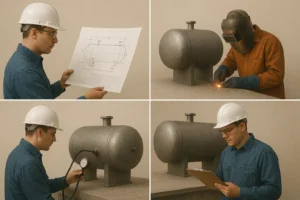
Pressure Vessel Design & Engineering: Concept to Launch
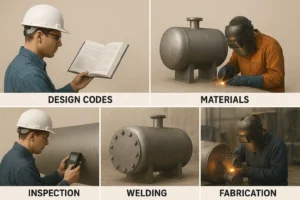
What is Pressure Vessel Design and Engineering: Code-Ready Guide
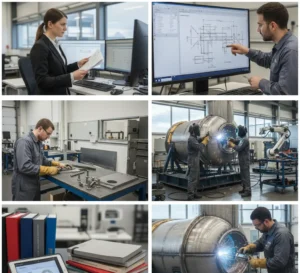
What are the Key Factors in Pressure Vessel Engineering
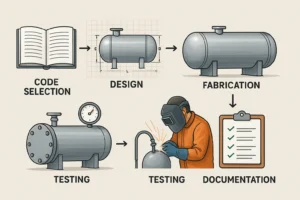
How Do You Design a Pressure Vessel: A Step-By-Step Guide
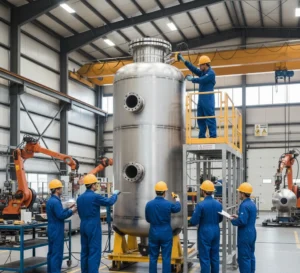
What is Pressure Vessel Fabrication and Manufacturing
About Author

